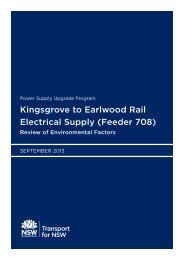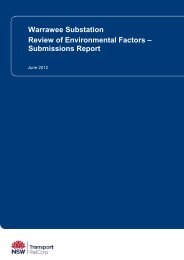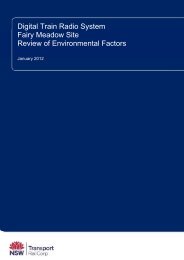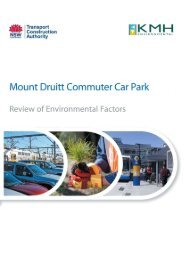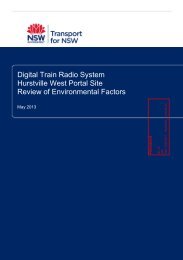Warrawee Substation - Review of Environmental Factors
Warrawee Substation - Review of Environmental Factors
Warrawee Substation - Review of Environmental Factors
- No tags were found...
You also want an ePaper? Increase the reach of your titles
YUMPU automatically turns print PDFs into web optimized ePapers that Google loves.
Scientific Name Common Name TSC/FMActEPBC Act Habitat Association Nature <strong>of</strong> Record Likelihood <strong>of</strong>occurrencePotential for impactsInhabits terrestrial and estuarine wetlands, generally inareas <strong>of</strong> permanent water and dense vegetation. Mayoccur in flooded grassland, forest, woodland,rainforest and mangroves as long as there ispermanent water. Roosts by day in trees or withinreeds on the ground. Nests in branches overhangingwater and breeds from December to March.2012a) No suitable habitat.EphippiorhynchusasiaticusBlack-necked Stork E - Primarily inhabits permanent freshwater wetlands andsurrounding vegetation including swamps, floodplains,watercourses and billabongs, freshwater meadows,wet heathland, farm dams and shallow floodwaters.Will also forage in inter-tidal shorelines, mangrovemargins and estuaries. Feeds in shallow, still water.This species breeds during summer, nesting in or neara freshwater swamp1 record within10km (OEH2012a)Unlikely.No suitable habitat.Nil.NettapuscoromandelianusCotton Pygmy-gooseE - Prefers freshwater lakes, lagoons, swamps and dams,particularly those vegetated with waterlilies and otherfloating and submerged aquatic vegetation. Thisspecies uses standing dead trees with hollows closeto water for roosting and breeding.4 records within10km (OEH2012a)Unlikely.No suitable habitat.Nil.Stagonopleura guttata Diamond Firetail V Typically found west <strong>of</strong> the Great Dividing Range, butpopulations also occur in drier coastal areas includingW Sydney, Hunter, Clarence and Snowy Rivervalleys. Occurs in grassy eucalypt woodlands includingBox Gum and Snow Gum communities, as well asopen forest, mallee and natural and derivedgrasslands. Often found in riparian areas and1 record within10km (OEH2012a)Unlikely.No suitable habitat.Nil.



